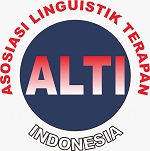Perspectives of Pre-Service English Teachers on AI Chatbots in ESP Worksheet Development
DOI:
https://doi.org/10.33394/jollt.v13i1.12964Keywords:
AI chatbot, Worksheet, ESP, Material developmentAbstract
References
Al-Tkhayneh, K. M., Alghazo, E. M., & Tahat, D. (2023). The Advantages and Disadvantages of Using Artificial Intelligence in Education. Journal of Educational and Social Research, 13(4), 105–117. https://doi.org/10.36941/jesr-2023-0094
Anis, M., & Scholar, R. (2023). Leveraging Artificial Intelligence for Inclusive English Language Teaching: Strategies and Implications for Learner Diversity 54 Leveraging Artificial Intelligence for Inclusive English Language Teaching: Strategies and Implications for Learner Diversity. Peer Reviewed and Refereed Journal, 6, 12. www.ijmer.in
Aryal, M. (2024). Exploring the Impact of ChatGPT in English Language Teaching-Learning Pedagogy. Journal of NELTA Gandaki, 7(1–2), 137–150. https://doi.org/10.3126/jong.v7i1-2.70236
Asad, M. M., & Ajaz, A. (2024). Impact of Chatgpt and Generative Ai on Lifelong Learning and Upskilling Learners in Higher Education: Unveiling the Challenges and Opportunities Globally. The International Journal of Information and Learning Technology, 41(5), 507–523. https://doi.org/10.1108/IJILT-06-2024-0103
Ayedoun, E., Hayashi, Y., & Seta, K. (2019). Adding Communicative and Affective Strategies to an Embodied Conversational Agent to Enhance Second Language Learners’ Willingness to Communicate. International Journal of Artificial Intelligence in Education, 29(1), 29–57. https://doi.org/10.1007/s40593-018-0171-6
Çobanoğulları, F. (2024). Learning and teaching with ChatGPT: Potentials and applications in foreign language education. The EuroCALL Review, 31(1), 4–15. https://doi.org/10.4995/eurocall.2024.19957
Darwin, Rusdin, D., Mukminatien, N., Suryati, N., Laksmi, E. D., & Marzuki. (2024). Critical thinking in the AI era: An exploration of EFL students’ perceptions, benefits, and limitations. Cogent Education, 11(1). https://doi.org/10.1080/2331186X.2023.2290342
Delgado, H. O. K., de Azevedo Fay, A., Sebastiany, M. J., & Silva, A. D. C. (2020). Artificial intelligence adaptive learning tools: the teaching of English in focus. Brazilian English Language Teaching Journal, 11(2). https://doi.org/10.15448/2178-3640.2020.2.38749
Dizon, G. (2024). ChatGPT as a Tool for Self-Directed Foreign Language Learning. Innovation in Language Learning and Teaching, 1–17. https://doi.org/10.1080/17501229.2024.2413406
Douali, L., Selmaoui, S., & Bouab, W. (2022). Artificial Intelligence in Education: Fears and Faiths. International Journal of Information and Education Technology, 12(7), 650–657. https://doi.org/10.18178/ijiet.2022.12.7.1666
Fitria, T. N. (2022). The Use Technology Based on Artificial Intelligence in English Teaching and Learning. February. https://doi.org/10.24235/eltecho.v
GarcÃa-Alonso, E. M., León-MejÃa, A. C., Sánchez-Cabrero, R., & Guzmán-Ordaz, R. (2024). Training and Technology Acceptance of ChatGPT in University Students of Social Sciences: A Netcoincidental Analysis. Behavioral Sciences, 14(7), 612. https://doi.org/10.3390/bs14070612
Grudin, J., & Jacques, R. (2019). Chatbots, humbots, and the quest for artificial general intelligence. Conference on Human Factors in Computing Systems - Proceedings, 1–11. https://doi.org/10.1145/3290605.3300439
I. Bocianu. (2024). Advantages And Disadvantages Of Using Ai Tools For Esp Students. Edulearn24 Proceedings, 10511–10518. https://doi.org/10.21125/edulearn.2024.2594
Khushboo Kuddus. (2022). Artificial Intelligence in Language Learning: Practices and Prospects. In A. K. T. Archana Mire, Shaveta Malik (Ed.), Advanced Analytics and Deep Learning Models (pp. 1–17). Wiley Online Library. https://doi.org/10.1002/9781119792437
Lee, J. E., & Maeng, U. (2023). Perceptions of High School Students on AI Chatbots Use in English Learning: Benefits, Concerns, and Ethical Consideration. Journal of Pan-Pacific Association of Applied Linguistics, 27(2), 53–72. https://doi.org/10.25256/paal.27.2.4
Nicky Hockly. (2023). Artificial Intelligence in English Language Teaching: The Good, the Bad and the Ugly. RELC Journal, 54(2). https://doi.org/https://doi.org/10.1177/00336882231168504
Sharadgah, T. A. (2022). a Systematic Review of Research on the Use of Artificial Intelligence in English Language Teaching and Learning ( 2015-2021 ): What are the Current Effects ? 21.
Ulla, M. B., Perales, W. F., & Busbus, S. O. (2023). ChatGPT in Language Education: How To Use It Ethically? Pasaa, 67(December), 361–377.
Zumstein, D., & Hundertmark, S. (2018). Chatbots: an interactive technology for personalized communication and transaction. IADIS International Journal on Www/Internet, 15(1), 96–109.
Downloads
Published
How to Cite
Issue
Section
Citation Check
License
License and Publishing Agreement
In submitting the manuscript to the journal, the authors certify that:
- They are authorized by their co-authors to enter into these arrangements.
- The work described has not been formally published before, except in the form of an abstract or as part of a published lecture, review, thesis, or overlay journal.
- That it is not under consideration for publication elsewhere,
- That its publication has been approved by all the author(s) and by the responsible authorities – tacitly or explicitly – of the institutes where the work has been carried out.
- They secure the right to reproduce any material that has already been published or copyrighted elsewhere.
- They agree to the following license and publishing agreement.
Copyright
Authors who publish with JOLLT Journal of Languages and Language Teaching agree to the following terms:
- Authors retain copyright and grant the journal right of first publication with the work simultaneously licensed under a Creative Commons Attribution License (CC BY-SA 4.0) that allows others to share the work with an acknowledgment of the work's authorship and initial publication in this journal.Â
- Authors are able to enter into separate, additional contractual arrangements for the non-exclusive distribution of the journal's published version of the work (e.g., post it to an institutional repository or publish it in a book), with an acknowledgment of its initial publication in this journal.
- Authors are permitted and encouraged to post their work online (e.g., in institutional repositories or on their website) prior to and during the submission process, as it can lead to productive exchanges, as well as earlier and greater citation of published work.
Licensing for Data Publication
- Open Data Commons Attribution License, http://www.opendatacommons.org/licenses/by/1.0/ (default)
This work is licensed under a Creative Commons Attribution-ShareAlike 4.0 International License.
















